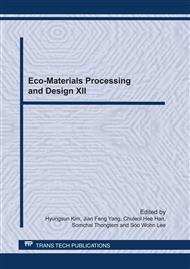p.186
p.190
p.194
p.198
p.202
p.206
p.211
p.215
p.219
Analysis of Laser and Resistance Spot Weldments on Press-Hardened Steel
Abstract:
For the manufacture of safe, lightweight vehicles, the demand for ultra-high-strength steel in the automotive industry is increasing. Although transformation-induced plasticity (TRIP) and dual-phase (DP) steels have a strength of under 1 GPa, boron-alloyed steel produced using the hot press forming process has a strength of more than 1500 MPa. Laser and resistance spot welding processes are used to join press-hardened steel, but the characteristics of the resulting weldments are not yet fully understood. In this study, the thermal cycles for both welding processes were investigated using finite element (FE) analysis. Resistance spot welding was analyzed using a combination of thermal, electric, and mechanical models, whereas the thermal behavior of laser welding was predicted using only a thermal model. The calculated bead shapes were compared with experimentally measured ones to validate the simulation models. The mechanical and metallurgical characteristics of the weldments were explained using the thermal history of each welding process.
Info:
Periodical:
Pages:
202-205
Citation:
Online since:
July 2011
Authors:
Keywords:
Price:
Сopyright:
© 2011 Trans Tech Publications Ltd. All Rights Reserved
Share:
Citation:


